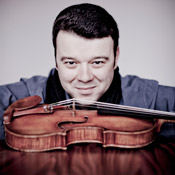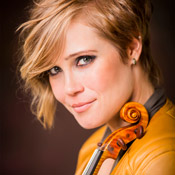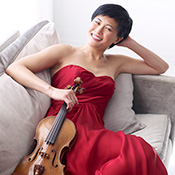
Violinist Tai Murray on Telling Musical Stories
David Lewellen
PUBLISHED
Tagged Under: 2024.25 Season, Guest Artist, Violin
Talk to Tai Murray about playing the violin, and more than once she will mention the importance of telling a story. But how do you tell a story about philosophy?
That is a question that any violinist must consider before performing Leonard Bernstein’s Serenade after Plato’s Symposium, which Murray will play May 30-31 with the Milwaukee Symphony Orchestra. But she has a lot of answers for how she can connect to the audience.
Bernstein’s piece, a violin concerto by any other name, took its inspiration from a philosophical dialogue by Plato about the nature of love. But Murray is quick to point out that the word “symposium,” which now sounds lofty and serious, also meant a drinking party in ancient Greece. “That’s something I can’t forget,” she said. She has read the Platonic dialogue and says that it’s an “intellectually interesting and fun back story,” but she still has to make a convincing case for Bernstein’s music.
“I find a lot of wit and a lot of dialogue in it,” she said. In the five-movement piece, thematic material from previous movements keeps reappearing in a different form. “A listener might say, ‘I heard that before; why is it in this form now?’ That’s my job.”
Asked about the technical requirements of the piece, Murray said immediately, “Excellent rhythm. If anything gets on a percussionist’s nerves, it’s a string player without rhythm.” (The piece is scored for strings, harp, and percussion, with no winds.) She will, of course, use rubato, but those slight variations of tempo within a measure will be worked out in rehearsal, “so it won’t be a complete surprise.”
Murray’s performance time is split between recitals, chamber music, and soloing with orchestras. “The way it gets divided up is just about scheduling,” she said. “I want to be well-rounded. I’m a good listener and I can react in the moment, and that’s one of the most helpful things a soloist can be.”
As well as performing, since 2021 she has also been on the music faculty at Yale, where she enjoys passing knowledge on to the next generation. “The violin is still a master-apprentice art,” she said. “You can’t learn it from a textbook.” She seeks out teaching in many different settings, and when she visits a city she will often include a master class or a school visit in her itinerary.
Yale also gave her the opportunity to record several short “mini master class” videos, covering topics such as body movement and playing with more color. “They’re universal things that everyone needs to study and everyone needs to hear,” she said.
By her own testimony in the video, Murray moves a lot when she plays. But the specifics “depend on what I’m playing and where I am,” she said. “If I say, ‘I’m a mover,’ that’s too abstract. What is helpful for me in the moment?”
Would she move differently for Bernstein than for Bach? “I don’t know,” she said. “But both of them come out of a dance tradition. I can’t dance and play at the same time — but I’m aware of what’s happening in my core.”
That kind of awareness also helps musicians prevent injury. “Music is highly intellectual and emotional and creative,” she said, “but it’s also physical. We can’t forget about the physical impact on our bodies. We’re also sports people, in a way, and sports people always build in recovery time.”
Murray, a native of Chicago, literally can’t remember a time when she didn’t play violin. “Apparently, I asked very young to play and I was persistent,” she said, “until my mother finally said yes and found me an excellent teacher.” From childhood on, she kept the goal of playing for a living, earning degrees from Indiana and Juilliard along the way. Now, she said, “I am what I said I wanted to be.”



